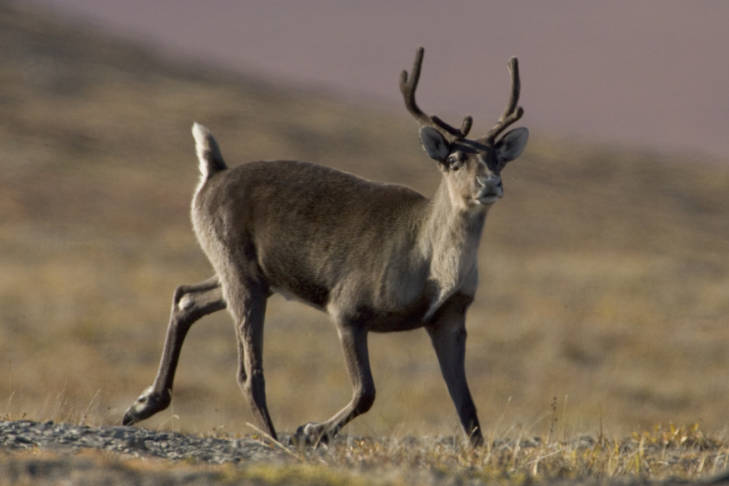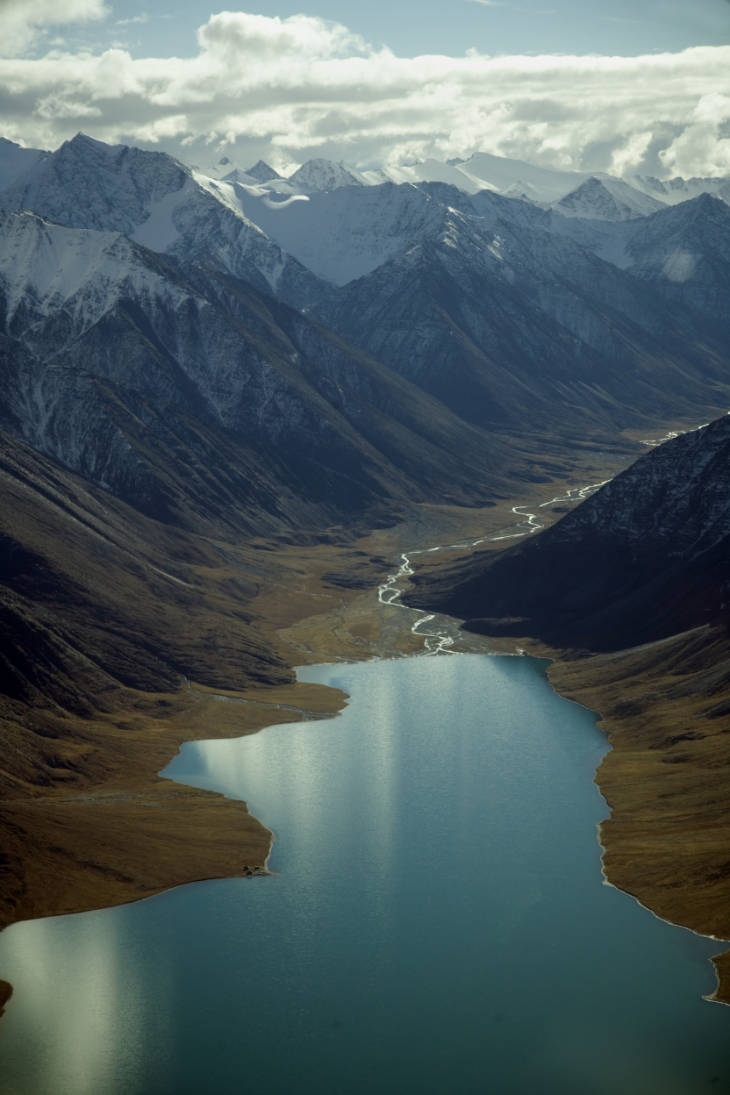Photo: Steve Hillebrand/USFWS
The deeply unpopular plan would benefit a few rich oil companies while threatening people, wildlife and the climate.
February 4, 2019 - by Tim Lydon
The Trump administration is barreling ahead with plans to drill for oil in Alaska’s Arctic National Wildlife Refuge, the largest refuge in the country and an area of global ecological importance.
Many refer to the coastal plain of the Arctic Refuge — the very place where oil drilling is being planned — as the “American Serengeti.” A home for grizzly bears, wolves, musk oxen and a host of other species, the area is famous as the birthing ground for the enormous Porcupine caribou herd, which each spring floods across the refuge’s coastal plain in the tens of thousands, arriving in time to raise newborn calves amid fresh tundra grasses. The coastal plain is also the annual destination for millions of migrating birds, who come from nearly every continent on Earth to raise the next generation of swans, terns and over 200 other species. In late summer these avian visitors disperse to backyards, beaches and wetlands across the planet.

Drilling on the Arctic Refuge has long been opposed by most Americans. Among the staunchest opponents of drilling are indigenous people in northern Alaska and the Canadian Arctic, whose cultures and diets are entwined with the Porcupine herd. They include the Gwich’in people of northern Alaska, who have lived in the Arctic for millennia and reside alongside the Arctic Refuge. Their name for the coastal plain is Iizhik Gwats’an Gwandaii Goodlit, or “the Sacred Place Where Life Begins,” a name reflecting the shared destiny of the caribou and the people. For the Gwich’in and others, fighting against drilling is a cultural imperative and a civil-rights issue.
The refuge has another cultural relevance: It’s a unique part of American conservation history. President Dwight Eisenhower’s 1960 protection of the area followed decades of research and advocacy by some of the tallest figures in American conservation, including Mardy and Olaus Murie, Bob Marshalland Supreme Court Justice William O. Douglas, among many others. These proponents held that the northeastern corner of Alaska should remain as one of America’s last truly wild places, to benefit future generations and the land itself. Informed by the predator-prey research of Olaus Murie and disappointed by a trend toward development in the national parks, advocates pressed for a version of preservation that excluded roads, facilities and interference with predators or other natural ecological forces. They wanted to preserve wilderness.

When Eisenhower’s orderprotected the area’s “unique wildlife, wilderness and recreational values,” it marked the first time federal law specifically protected a thing called wilderness. As Roger Kaye describes in his book The Last Great Wilderness, the move was a precursor to the 1964 Wilderness Act, which the Muries also helped shape and which remains among our bedrock conservation laws. Later, in 1980, Congress affirmedthe national significance of the Arctic Refuge by nearly doubling its size.
But to the current administration and its loyal allies in Congress, the coastal plain of the Arctic Refuge is destined to be an industrial oilfield. Caribou, birds, native people and history be damned — to say nothing of the climate, which needs another industrial oilfield about as much as Donald Trump needs another criminal investigation into his presidency.
We arrived at this pivotal moment after Republicans, following decades of failed attempts, used the 2017 tax law to pry open Arctic Refuge protections. Led by Alaska Sen. Lisa Murkowski, they tacked a provision onto the law’s last page, in Section 20001, mandating drilling on the area’s coastal plain. The law even amended the refuge’s enabling legislation to include oil drilling as a purpose of the refuge. Absurdly, drilling for oil now stands alongside other refuge purposes such as maintaining environmental health, conserving wildlife and protecting the wilderness values Eisenhower singled out back in 1960.
The law also prescribed a strict timetable for drilling. It orders the government to offer a minimum of two massive lease sales in the next 10 years, with the first to be completed by 2021. Each must encompass at least 400,000 acres of the coastal plain and include rights-of-way for a tangle of pipelines, roads, airstrips and other infrastructure, all certain to harm the natural values of the refuge.
Designing those lease sales is the focus of the government’s work today. The process began with an initial public comment period last spring, which garnered nearly 700,000 responses that overwhelmingly opposed drilling. We are now in the second comment period, which quietly opened during the holidays and was originally scheduled to close on February 11 — a period mostly characterized by President Trump’s 35-day government shutdown. The purpose of the comment period is to gather input on an array of generally weak environmental restrictions proposed to govern the lease sales the administration hopes to offer this year. It’s all part of a fast-tracked attempt to transfer large swaths of the coastal plain into oil-industry hands before the 2020 election.
Comments have now been extended through March 13, but the shutdown also resulted in the Interior Department postponing a series of public meetings, which would have enabled people to learn more about the sales. Those meetings are now scheduled to take place this week.
Still, comments were accepted throughout the shutdown. Based on published media reports we know they already include recent objections from the Canadian government, the governments of the Yukon and Northwest Territories, and several Canadian First Nations groups, who all agree drilling on the coastal plain violates international agreements to protect the Porcupine caribou.
Meanwhile the government is expected to invite more public comment soon, this time on the impacts of seismic testing on the refuge. This destructive process, which will unleash convoys of giant “thumper trucks” onto the coastal plain, was previously conducted in 1985 under the Reagan administration. Monitoring a quarter-century later showed that more than 120 miles of ruts still scar the fragile tundra, their hard angles and straight lines intercepting the ponds and meandering streams of the natural landscape. Although testing was scheduled to begin next month, it has been slowed by evidence it may harm or kill denning polar bear mothers and cubs. Ironically, unseasonable warmth and President Trump’s chaotic government shutdown also slowed the process.
The Gwich’in Steering Committee, which includes Alaska Native people who grew up alongside the refuge and have been nourished by its caribou and other resources, are not laying all of their hopes on the comment period. On January 14 their representatives joined other indigenous people in Houston, Texas, to hand-deliver 100,000 letters pressuring SAExploration to withdraw its bid to perform the testing. The Sierra Club reports at least 200,000 emails, calls and letters have been sent to the company, the sole outfit to bid on the project.
The direct appeal to SAExploration reveals how resistance to drilling continues outside of formal comment periods — and it shows signs of success. Last month international bankers at Barclays responded to public pressure by announcing they are unlikely to finance drilling in the Refuge because it is a “particularly fragile and pristine ecosystem.”
Here’s the final insult about drilling in the refuge: It’s not necessary, either economically or for the energy it would produce. Fracking technology and decades of generous public lands giveaways to the oil industry have already given the United States undeniable global energy dominance. Drilling in the Arctic Refuge is an unnecessary excess, especially when we consider that the oil from far-off northern Alaska would most likely be sold for corporate profit to foreign markets, not to support America’s energy needs. All it would serve is to line a few companies’ pockets.
As the accelerated and sometimes confusing work to drill in the refuge moves forward, the time to stop this from happening — and prevent permanent harm to this extraordinary landscape — grows increasingly short. It’s also a reminder of the threat the current government and extractive industries pose to our vital public lands. This is an important fight for wildlife, for wilderness, for the rights of indigenous peoples and for the climate. The Arctic Refuge may be remotely located and out of sight for most Americans, but it should not be out of mind.
The opinions expressed above are those of the author and do not necessarily reflect those of The Revelator, the Center for Biological Diversity or their employees.












Đăng nhận xét